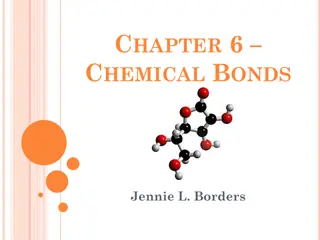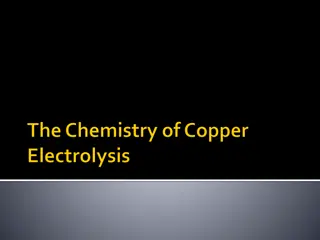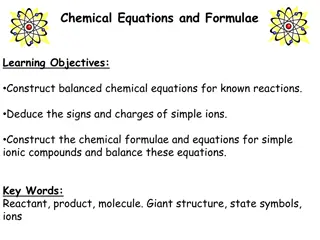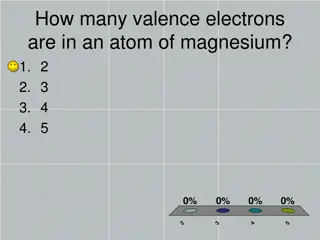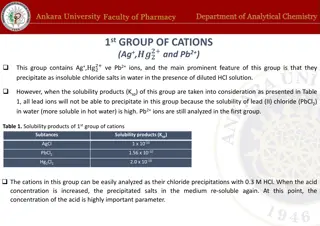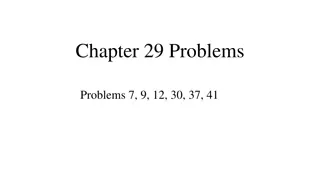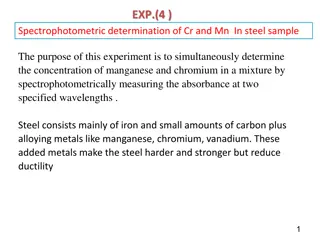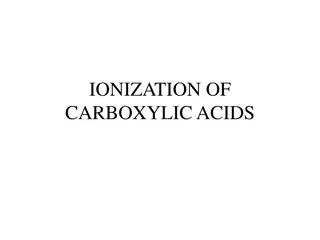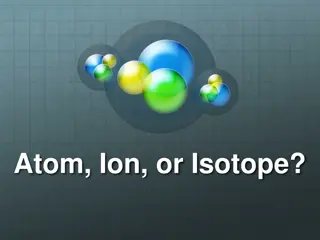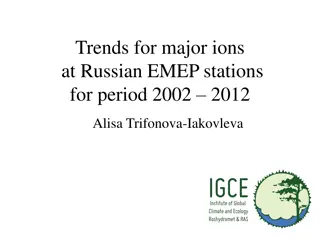
Ionic Compounds and Nomenclature
Explore the world of ions, cations, anions, and polyatomic ions in chemistry. Learn about ionic compounds, their nomenclature, and how to write chemical formulas. Discover the significance of fixed-charge cations and elemental anions in the formation of salts. Enhance your knowledge with examples and memorization tips for common polyatomic ions.
Download Presentation

Please find below an Image/Link to download the presentation.
The content on the website is provided AS IS for your information and personal use only. It may not be sold, licensed, or shared on other websites without obtaining consent from the author. If you encounter any issues during the download, it is possible that the publisher has removed the file from their server.
You are allowed to download the files provided on this website for personal or commercial use, subject to the condition that they are used lawfully. All files are the property of their respective owners.
The content on the website is provided AS IS for your information and personal use only. It may not be sold, licensed, or shared on other websites without obtaining consent from the author.
E N D
Presentation Transcript
ion: a charged particle (i.e., a charged atom or group of atoms) Ions and Ionic Compounds anion: a ( ) ion -- more e than p+ cation: a (+) ion -- more p+ than e a cation a fish a cat keeping anion a fish -- -- formed when atoms gain e formed when atoms lose e Anions are negative ions. When I see a cation, I see a positive ion; A + that is, I C ion.
polyatomic ion: a charged group of atoms Memorize: NH4+ CH3COO PO43 MnO4 ammonium acetate phosphate permanganate NO3 ClO3 BrO3 IO3 nitrate chlorate bromate iodate chromate dichromate CN OH cyanide hydroxide CrO42 Cr2O72 carbonate bicarbonate sulfate bisulfate CO32 HCO3 SO42 HSO4
Ionic compounds, or salts, consist of oppositely-charged species bonded by electrostatic forces. You can describe salts as metal-nonmetal, but cation-anion is better.
Nomenclature of Ionic Compounds chemical formula: has neutral charge; shows types of atoms and how many of each To write an ionic compound s formula, we need: 1. the two types of ions 2. the charge on each ion NaF Na+ and F BaO Na2O BaF2 Ba2+ and O2 Na+ and O2 Ba2+ and F
Parentheses are reqd only with multiple bunches of a particular polyatomic ion. Ba2+ and SO42 Mg2+ and NO2 NH4+ and ClO3 Sn4+ and SO42 Fe3+ and Cr2O72 NH4+ and N3 BaSO4 Mg(NO2)2 NH4ClO3 Sn(SO4)2 Fe2(Cr2O7)3 (NH4)3N
Fixed-Charge Cations with Elemental Anions i.e., pulled-off-the- Table anions For this class, the fixed-charge cations are groups 1, 2, 13, and Ag+, Zn2+, Cd2+, Sc3+, Y3+, Zr4+, Hf4+, Ta5+.
Na A. To name, given the formula: Ba 1. Use name of cation. 2. Use name of anion (it has the ending ide ). sodium fluoride NaF barium oxide BaO sodium oxide Na2O BaF2 barium fluoride
Zn Ca Ag B. To write formula, given the name: 1. Write symbols for the two types of ions. 2. Balance charges to write formula. Ag+ Ag2S S2 silver sulfide Zn2+ P3 Zn3P2 zinc phosphide I CaI2 Ca2+ calcium iodide
Variable-Charge Cations with Elemental Anions i.e., pulled-off-the- Table anions For this class, the variable-charge cations are Pb2+/Pb4+, Sn2+/Sn4+, and all transition elements not listed above.
A. To name, given the formula: Cu Fe 1.Figure out charge on cation. 2. Write name of cation. 3. Write Roman numerals in ( ) to show cation s charge. 4. Write name of anion. Stock System of nomenclature Fe? Fe2+ iron(II) oxide FeO O2 Fe3+ Fe? O2 O2 Fe2O3 CuBr Fe3+ Fe? O2 iron(III) oxide Cu? Br Cu+ copper(I) bromide CuBr2 Cu2+Br Cu? copper(II) bromide Br
B. To find the formula, given the name: 1. Write symbols for the two types of ions. 2. Balance charges to write formula. Co Sn cobalt(III) chloride Co3+Cl CoCl3 Sn4+ O2 SnO2 tin(IV) oxide Sn2+ tin(II) oxide O2 SnO
Compounds Containing Polyatomic Ions Insert name of ion where it should go in the compound s name. But first... oxyanions: polyatomic ions containing oxygen Most common oxyanions: BrO3 IO3 ClO3 NO3 nitrate bromate iodate chlorate PO43 SO42 CO32 phosphate sulfate carbonate
If an oxyanion differs from the above by the # of O atoms, the name changes are as follows: one more O = per_____ate most common # of O = _____ate one fewer O = _____ite two fewer O = hypo_____ite
Write formulas: iron(III) nitrite Fe3+NO2 Fe(NO2)3 (NH4)3P NH4ClO2 Zn3(PO4)2 ammonium phosphide NH4+ NH4+ Zn2+PO43 Pb2+MnO4 Pb(MnO4)2 P3 ClO2 ammonium chlorite zinc phosphate lead(II) permanganate
Write names: (NH4)2SO4 ammonium sulfate silver bromate AgBrO3 (NH4)3N ammonium nitride CrO42 U6+ uranium(VI) chromate U?CrO42 CrO42 Cr? Cr? Cr3+ SO32 U(CrO4)3 Cr2(SO3)3 chromium(III) sulfite Cr3+ SO32 SO32
Hydrogen hydroxide: A Tale of Danger and Irresponsibility -- THE major component of acid rain -- found in all cancer cells -- inhalation can be deadly -- excessive ingestion results in acute physical symptoms: e.g., frequent urination, bloated sensation, profuse sweating -- often an industrial byproduct of chemical reactions; dumped wholesale into rivers and lakes toxic_chemical_storage
Acid Nomenclature binary acids: acids w/H and one other element Binary Acid Nomenclature 1. Write hydro. 2. Write prefix of the other element, followed by -ic acid. HF HCl hydrofluoric acid hydrochloric acid hydrobromic acid HBr hydroiodic acid HI hydrosulfuric acid H2S
Hydrooxic Acid: A Tale of Danger and Irresponsibility -- THE major component of acid rain -- found in all cancer cells -- inhalation can be deadly -- excessive ingestion results in acute physical symptoms: e.g., frequent urination, bloated sensation, profuse sweating -- often an industrial byproduct of chemical reactions; dumped wholesale into rivers and lakes toxic_chemical_storage
oxyacids: acids containing H, O, and one other element Oxyacid Nomenclature For most common forms of the oxyanions, write prefix of oxyanion, followed by -ic acid. HBrO3 HClO3 H2CO3 sulfuric acid bromic acid chloric acid carbonic acid H2SO4 H3PO4 phosphoric acid
If an oxyacid differs from the above by the # of O atoms, the name changes are: one more O = per_____ic acid most common # of O = _____icacid one fewer O = _____ous acid two fewer O = hypo_____ous acid HClO4 HClO3 HClO2 HClO perchloric acid chloric acid chlorous acid most common hypochlorous acid H3PO3 HBrO H2SO5 phosphorous acid hypobromous acid persulfuric acid


